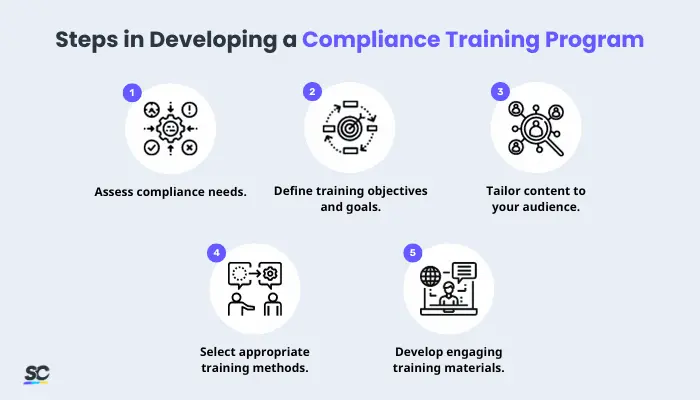What is Compliance Training?
Compliance training is a form of training provided to employees within an organization to ensure they understand and adhere to the relevant laws, regulations, policies, and ethical standards that govern their industry or company. It aims to promote lawful and ethical behavior, minimize the risk of legal violations or unethical conduct, and protect the organization’s reputation and integrity. It also helps organizations consistently meet legal and regulatory requirements for the health and safety of workers, as well as the quality of business operations.
Why is Compliance Training Important?
Compliance training is a vital component of any organization’s operations and serves as the cornerstone for various legal and regulatory considerations of a business. Here are some key reasons why this training holds such significance:
- Legal Adherence : Ensures employees are informed about relevant laws, reducing the risk of legal violations and associated fines.
- Risk Mitigation : Identifies and addresses potential compliance risks early, preventing breaches and protecting the organization from reputational and financial harm.
- Reputation Protection : Fosters a culture of ethical behavior, maintaining trust with customers, partners, and stakeholders.
- Ethical Foundation : Instills ethical values, guiding employees to make principled decisions in their roles.
- Employee Accountability : Promotes accountability, reducing the likelihood of unethical or illegal behavior.
- Competitive Advantage : Enhances market position by demonstrating a commitment to ethical and legal conduct.
How to Develop a Training Program for Compliance

Steps in Developing a Compliance Training Program
Planning and creating comprehensive training sessions for compliance-related efforts entails a careful process to ensure its efficiency and effectiveness. So, what should be included in compliance training, and how should a program for it be created? Here are the key steps you can follow:
1. Assess compliance needs.
Begin by conducting a thorough assessment of your organization’s compliance requirements. Identify the specific laws, regulations, and internal policies that are relevant to your industry and operations. This assessment will serve as the foundation for your training program.
2. Define training objectives and goals.
Clearly outline the purpose and measurable goals of your compliance training program. Determine what you want employees to learn and achieve through the training to guide the development of your training content and materials.
3. Tailor content to your audience.
Acknowledge that different employees may have varying levels of familiarity with compliance issues. This is why it’s important to tailor your training content to the needs and knowledge levels of your audience and ensure that the material is accessible and engaging for all employees.
4. Select appropriate training methods.
Choose the most suitable training methods for your organization. This may include in-person workshops, online courses, seminars, or a combination of these. Remember to consider the practicality, cost-effectiveness, and accessibility of each method to ensure a holistic compliance training plan.
5. Develop engaging training materials.
Create or source materials that are engaging and informative. You can use a variety of media, such as videos, interactive modules, and case studies, to make the training more effective. Ensure that the content is clear, concise, and easy to understand.
6. Conduct the Training
Roll out the training program to your employees, keeping track of their progress and completion. Make sure to implement a system to monitor and document training activities. Also, regularly update the training content to reflect changes in compliance requirements.
7. Document and Evaluate
Maintain detailed records of training activities, including attendance, assessments, and completion certificates. These records serve as documentation of your organization’s commitment to compliance. Conduct assessments or quizzes to evaluate participants’ comprehension of the training material or topic.
Common Challenges in Conducting This Training
Effective compliance training faces several challenges, including motivating employee engagement, keeping content up-to-date with changing regulations, addressing cultural and language diversity in multinational organizations, maintaining comprehensive compliance records, and balancing various training delivery methods to suit diverse learning preferences and practical constraints. Being aware and addressing these challenges is key to creating an effective compliance training program.
Create Your Own Compliance Training Checklist
Eliminate manual tasks and streamline your operations
Get started for FREECompliance Training Examples
Various compliance training programs can be classified into three major types:
- General – applicable to most jobs, businesses, and industries
- Industry-specific – designed to fit unique industry requirements
- Job-specific – created to help employees perform their work well and in accordance with organizational policies (e.g., Human Resources (HR) compliance) and regulatory standards
As an overview, here are compliance training examples in different areas:
Workplace Safety
- OSHA (Occupational Safety and Health Administration) – In the US, OSHA sets safety and health standards for workplaces. Typically, OSHA compliance training covers topics like hazard identification, workplace inspections, and emergency response procedures.
- Safe Work Australia – Safe Work Australia provides guidelines and regulations for workplace health and safety. Training focuses on risk assessment, safe work practices, and compliance with Australian safety standards.
- ILO (International Labour Organization) – The ILO sets international labor standards, so the training under ILO guidelines emphasizes global best practices for workplace safety.
- EHS (Environmental, Health, and Safety) – EHS compliance training is a general approach to ensuring workplaces are environmentally responsible and safe for employees. Topics in this training include waste management, chemical handling, and accident prevention.
Data Protection and Privacy
- HIPAA (Health Insurance Portability and Accountability Act) – HIPAA compliance training is essential for healthcare professionals in the U.S. It covers patient data protection, privacy rules, and the secure handling of medical records.
- GDPR (General Data Protection Regulation) – GDPR mandates strict data protection and privacy regulations in the European Union. Training on compliance helps organizations understand and adhere to GDPR’s principles, including consent, data minimization, and breach reporting.
- Data Protection Act – In the United Kingdom, the Data Protection Act enforces data protection laws. Training ensures that organizations process personal data legally and responsibly, addressing issues like data subject rights and data security.
Quality
- ISO (International Organization for Standardization) – ISO standards provide a framework for quality management. Training for ISO standard compliance, such as ISO 9001, focuses on quality processes, continuous improvement, and customer satisfaction.
- IATF (International Automotive Task Force) – Automotive manufacturers adhere to IATF standards (IATF 16949) for quality management, quality control methods, defect prevention, and supply chain management.
- GMP (Good Manufacturing Practices) – GMP training is crucial for pharmaceutical and food industries. It ensures compliance with quality and safety standards in the production and distribution of goods, including hygiene, documentation, and quality assurance.
- HACCP (Hazard Analysis Critical Control Points) – HACCP compliance training in the food production and processing industry follows a systematic approach to food safety. This includes identifying and mitigating hazards at critical points in the production process, and verification procedures to ensure the safety of food products.
FAQs About Compliance Training
Within an organization, specific departments or roles may be responsible for different aspects of compliance training. Here are key stakeholders who may play a role in providing this training program:
- HR Department
- Compliance Department
- Legal Counsel
- Training and Development Teams
- Subject-Matter Experts (SMEs)
- Leaders and Managers
- Employees
The frequency of compliance training varies depending on several factors, including industry regulations, the organization’s specific needs, and the nature of the compliance requirements. Here are some general scenarios on when it should be required:
- Annual Compliance Training
- New Hire Training
- Role-Specific Training
- Ongoing Training
- Certification Renewal
In most organizations, the requirement of undergoing compliance training for employees is common practice, and it typically applies to everyone, regardless of their roles or positions within the company. The goal, however, is to strike a balance between providing a baseline of compliance knowledge to all employees and addressing specific needs related to their job functions.
Compliance training isn’t the same for every organization, as various factors must be considered. These include the following:
- Industry-Specific Regulations
- Company Size
- Geographic Location
- Organizational Structure
- Regulatory Changes
- Organizational Culture
- Risk Profile
Therefore, compliance training is a highly customized and organization-specific responsibility designed to address the unique challenges and obligations each company faces.




